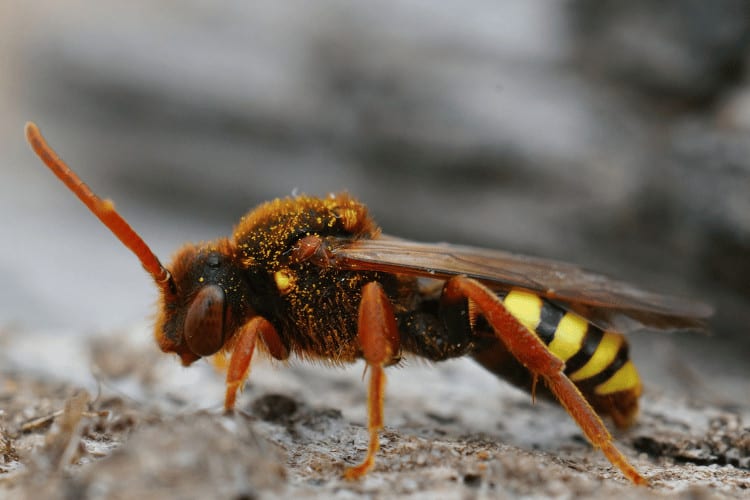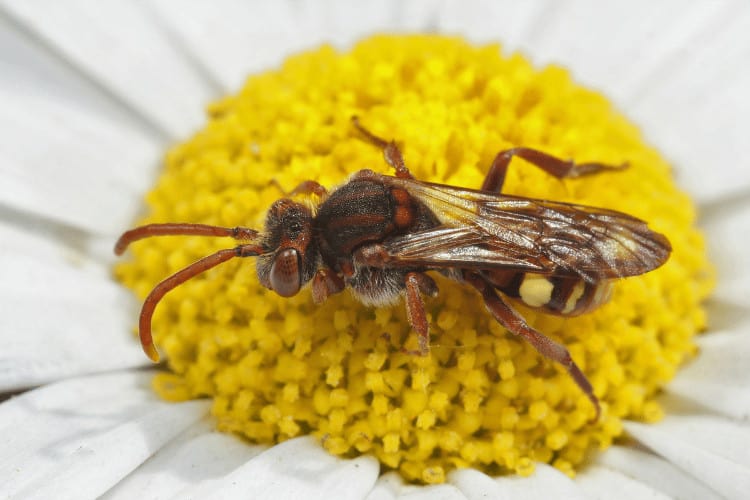Getting to Know the Nomad Bee
Nomad bees are an interesting bee species to me because they’re masters of deception! They don’t build their own nests but instead lay their eggs in the nests of other bees (host species).
That’s why they can be a nuisance to the majority of beekeepers. They tend to lay their eggs in the nests of honeybees!
In this article, I’ll take a closer look at nomad bees to discuss their behavior and invasive nesting habits. I’ll also share some tips if you want to avoid having your honeybee hives parasitized by nomad bees.
Physical Description and Personality Characteristics of Nomad Bees

Nomad bees (Nomada spp.) are a genus of solitary bees in the bee family Apidae. There are over 3,000 species of nomad bees, making them one of the largest genera of bees.
The scientific name of nomad bees comes from the Greek word “nomos,” which means “wanderer.” This is a reference to the fact that nomad bees don’t build their own nests, preferring to occupy the nests of other bees.
They’re also known as cuckoo bees.
Physical Appearance
What do these wasp-like nest invaders look like? I’m about to answer this question by describing two of the most common nomad bee species: Gooden’s bee and Marsham’s bee.
Gooden’s Nomad Bee (Nomada goodeniana)
Gooden’s nomad bee is a black and yellow bee easily identifiable by its distinctive markings. The abdomen has three complete yellow bands, with the first band having a broken appearance.
You’ll also notice two yellow markings at the base of each wing, accompanied by a pair of yellow spots at the bottom of the thorax.
The antennae and legs are usually orange, with the males having black markings on the antennae.
Marsham’s Nomad Bee (Nomada marshamella)

The most notable difference between this bee and the previous one is the spot at the base of each wing. Here, it’s orange instead of yellow.
The abdomen of Marsham’s nomad bee has three yellow bands, too, but the first and second ones are broken. This gives the abdomen a somewhat zigzagged appearance.
As for the legs and antennae, they’re similar to those of Gooden’s nomad bee.
Character and Behavior
Nomad bees are solitary bees, which means they don’t live in colonies. They’re also kleptoparasites; their larvae depend on the food supply stashed in the nests of other bees (typically mining bees) for sustenance after hatching!
These bees are active during the day. They fly from flower to flower, feeding on nectar but not pollen. Since they don’t have scopa pr hair patches on their bodies, they’re poor pollinators.
I wasn’t surprised to find during my research that nomad bees aren’t very social! They don’t communicate with each other in the same way that honeybees do. However, they use pheromones to mark their nests and to attract mates.
Is There a Purpose for Keeping Nomad Bees?
No.
Keeping nomad bees isn’t beneficial to a beekeeper, whether you’re just starting out or have been pursuing this hobby for a while.
For starters, they don’t produce any honey, nor are they good pollinators. Additionally, keeping these bees could potentially harm the host bees that they parasitize, jeopardizing your beekeeping business.
Instead, you may want to consider honeybees or bumblebees.
Honeybees are the most common type of bee kept by beekeepers for their ability to produce large quantities of honey.
Bumblebees are a bit smaller, but they’re more cold-tolerant and can be used to pollinate crops in cooler climates.
Nomad Bee Habitat and Foraging Preferences
Nomad bees are found in a huge variety of habitats, but they’re most common in open areas with abundant flowers, such as meadows, prairies, and fields.
The type of flowers that these bees prefer depends on the species. Some species prefer certain flowers, while others are generalists.
You’ll also have a higher chance of coming across these parasites near the nest sites of other bees, especially those from the genus Andrena. They usually hover low over the ground, searching for these nests.
Where Can You Find Nomad Bees?
Nomad bees are widespread on all continents except Antarctica. They’re most common in temperate and warm regions, but some species can be seen in cold regions.
- Europe: The United Kingdom, France, Germany, Italy, and Spain
- North America: Most parts of North America, including the United States, Canada, and Mexico
- South America: Brazil, Argentina, and Chile
- Africa: The Sahara Desert and the rainforests of Central Africa
- Asia: China, India, and Japan
- Australia: The Outback and the rainforests of Queensland
Nomad bees are also found on some islands, such as the Hawaiian Islands and Galapagos Islands.
The specific nomad bee species you can find in a particular region depends on the climate and the types of flowers available.
Nomad Bees Life Cycle, Mating, and Nesting
Nomad bees have a relatively short life cycle.
The female cuckoo bee mates in the spring and then lays her eggs in host nests. She uses her high sense of smell to detect those nests, waiting until the adult bee nest owners leave before hijacking them. However, she doesn’t occupy the cells herself, only her eggs.
The female nomad bee will often lay eggs in the host cells of bees similar in size and appearance. This helps to ensure that the larvae will have enough food to survive.
Afterward, the eggs hatch into larvae, feeding on the pollen and nectar that the host bees have stored. They’ll even kill the host bee’s eggs, too!
The larvae pupate and then emerge as adult bees in the summer.
Importance of Nomad Bees in Ecosystems
Cuckoo bees aren’t considered good pollinators, so they don’t contribute to the growth and survival of plants and crops. That is, again, because their bodies lack pollen-collecting hairs.
However, my research suggests that nomad bees may still play a role in the ecosystem by helping control pest populations. They might feed on the likes of aphids and caterpillars.
They may also disperse plant seeds, though not as effectively as other bee types.
Common Questions About Nomad Bees
What size are nomad bees?
Nomad bees are medium-sized bees, typically measuring between 7 and 14 millimeters in length. They’re slender with long, thin legs, which makes them appear even taller!
You should know that the size of nomad bees can vary depending on the species and the environment. For example, nomad bees that live in colder climates may be smaller than those that thrive in warmer regions.
Here is a table that summarizes the size of some common species of nomad bees:
| Species | Length in mm |
| Nomada marshamella | 10 to 13 |
| Nomada goodeniana | 9 to 13 |
| Nomada flava | 7.5 to 10 |
| Nomada fulvicornis | 10 to 14 |
What do nomad bees eat?
The type of food that nomad bees eat depends on the species of host bee that they parasitize.
However, most nomad bees, especially the larvae, eat the pollen and nectar left by the host bees. Sometimes, these bees will feed on smaller insects, too.
Are nomad bees dangerous?
Despite being a pain for beekeepers and their vulnerable beehives, these bees aren’t dangerous.

They don’t live in colonies, so they don’t feel compelled to defend their nests like other bee species. In other words, they simply don’t have a reason to sting humans.
Still, speaking from experience, all bees can sting you if they feel like you’re threatening their personal space! So, here are some tips for avoiding being stung by a nomad bee:
- Don’t disturb a nomad bee’s nest.
- If you see a nomad bee, don’t swat at it or try to catch it.
- If you get stung by this bee, remove the stinger as quickly as possible and apply a cold compress to the area.
- Seek immediate medical help if you’re allergic to bee stings.
How to keep nomad bees away?
There are a few things that beekeepers can do to keep nomad bees away from their hives:
- Place the hives in a sunny location: Nomad bees aren’t fans of sunny areas, so placing the hives in a sunny spot might deter them.
- Use a screen mesh: Place it around the hives to prevent nomad bees from entering.
- Put the hives in an area with few flowers: Cuckoo bees are attracted to flowers. Placing the hives in an area with fewer or no flowers can keep them away.
- Remove the nomad bee’s nest: If you find a nomad bee’s nest near your hives, you can remove it. Do this carefully and protect your skin to prevent getting stung.
To Wrap It Up
So there you have it; everything you need to know about nomad bees.
We’ve covered a lot of ground in this article, from the distinctive markings of nomad bees to their gruesome lifestyle! We’ve also learned about their diet, strange nesting habits, and how to keep them away from beehives.
While these buddies are fascinating to watch, they can be a beekeeper’s nightmare. So, always take the necessary measures to repel them.
